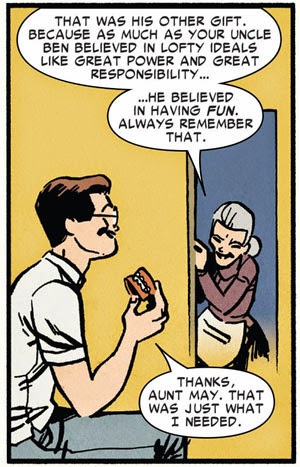R: ALF #16 (June 1989), art by Dave Manak
(Click picture to Piz Gloria-size)
The conversation in the bar-parlour of the Anglers' Rest had drifted round to the subject of the Arts: and somebody asked if that film-serial, The Vicissitudes of Vera, which they were showing down at the Bijou Dream, was worth seeing.There's a wonderful literary accounting of exclamations in this bit, in which headmasters and bishops try to nail down who vandalized a school statue:
'It's very good,' said Miss Postlethwaite, our courteous and efficient barmaid, who is a prominent first-nighter. 'It's about this mad professor who gets this girl into his toils and tries to turn her into a lobster.'
'Tries to turn her into a lobster?' echoed we, surprised.
'Yes, sir. Into a lobster. It seems he collected thousands and thousands of lobsters and mashed them up and boiled down the juice from their glands and was just going to inject it into this Vera Dalrymple's spinal column when Jack Frobisher broke into the house and stopped him.'
'Why did he do that?'
'Because he didn't want the girl he loved to be turned into a lobster.'
'What we mean,' said we, 'is why did the professor want to turn the girl into a lobster?'
'He had a grudge against her.'
This seemed plausible, and we thought it over for a while.
...'Run away, my boy, run away, run away. Can't you see we're busy?'What makes it funny? That in truth the bishop and the general are the paint-happy culprits, having been riled up the previous night with a liberal dose of "Mulliner's Buck-U-Uppo," that miracle patented medicine which gives you the bravery and nerve for difficult deeds. What makes it funnier? That the boy confessing is young Mulliner, nephew of the bishop's curate, who put the boy up to the confession to save his job. What makes it funniest? Mulliner's Buck-U-Uppo is actually an elephant tonic, with enough strength to keep those mighty pachyderms from shying and startling while on hunts in the Indian jungle.
'But, sir, please, sir, it's about the statue.'
'What about the statue? What about it? What about it?'
'Sir, please, sir, it was me.'
'What! What! What! What! What!'
The bishop, the general, and the headmaster had spoken simultaneously: and the 'Whats' has been distributed as follows:
The Bishop 1
The General 3
The Headmaster 1
making five in all. Having uttered these ejaculations, they sat staring at the boy, who turned a brighter vermillion.
Externally, ffinch Hall was one of those gloomy, somber country-houses which seem to exist only for the purpose of having horrid crimes committed in them. Even in his brief visit to the grounds, Wilfred has noticed fully half a dozen places which seemed incomplete without a cross indicating spot where body was found by the police. It was the sort of house where ravens croak in the front garden just before the death of the heir, and shrieks ring out from behind barred windows in the night.In truth, the only fiend there is the suspicious guardian of his love Angela:
'Sir Jasper Finch-Farrowmere?' said Wilfred.ffinch-ffarrowmere is trying to steal Angela away for himself, which gives Wilfred cause to rant:
'ffinch-ffarrowmere,' corrected the visitor, his sensitive ear detecting the capital letters.
'Ah, yes. You spell it with two small f's.'
'Four small f's.'
'Pooh to you!" said Wilfred. 'And, if you want to know what I think, you poor ffish, I believe your name is spelled with a capital F, like anybody else's.'But the ffinishing stroke is this:
Stung to the quick, the baronet turned on his heel and left the room without another word.
He shook a menacing finger at the baronet. 'You little thought, Sir Jasper ffinch-ffarrowmere, when you embarked on this dastardly scheme, that Wilfred Mulliner was watching your every move. I guessed your plans from the start. And now is the moment when I checkmate them. Give me that key, you Fiend.'But in between the moments of chuckling comedy, Wodehouse is as always skilled at turning a lyric and sentimental scene that touches the heart:
'ffiend,' corrected Sir Jasper, automatically.
It was as he was passing the Houses of Parliament that the realization came to him that strange bubbly sensation that seemed to start from just above the lower left side-pocket of his waistcoat was not, as he had first supposed, dyspepsia, but love. Yes, love had come at long last to Clarence Mulliner; and for all the good it might just as well have been the dyspepsia for which he had mistaken it. He loved a girl whom he would probably never see again. He did not know her name or where she lived or anything about her. All he knew was that he would cherish her image in his heart for ever, and that the thought of going on with the old dreary round of photographing lovely women with coy yet roguish smiles was almost more than he could bear.After reading that bit, you may think that Wodehouse has no bearing on our everyday lives, that he has nothing to tell the youth of today, that the sentiments he writes about aren't popular today. You think so, huh?:
